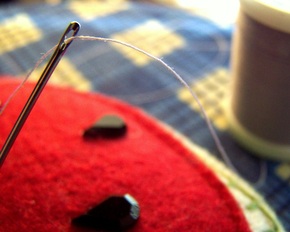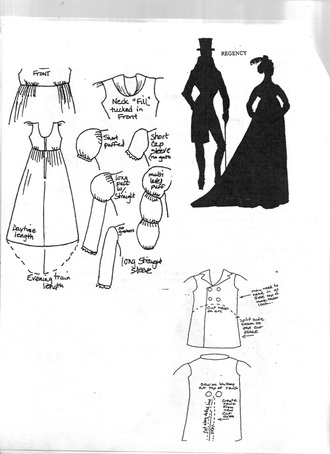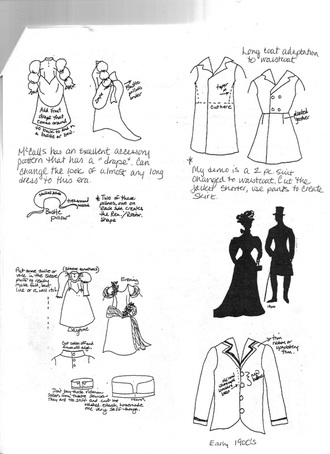|
I started this blog to allow those visiting my portfolio a better understanding of me as a person as well as to chronicle my newly begun journey. In addition, I wanted to create a place that would have relevant insight for young costumers like myself. There are plenty of things they do not teach you in undergrad about the industry, and it can be difficult to find answers specifically geared towards costuming. Currently this blog does not have much of a following; just a few friends and family members peruse once and a while, but I'm ok with that. If it helps one or two people with a puzzling question or just entertains for a few minutes I'm happy. A year (almost) after starting this blog I want to share more about my choosing of this career. I spoke about how my love of history got me into costuming in a previous post: here. This was also the topic of one of my personal statements when applying for my MFA. "Histoire is the French word for story. Our histories are our stories... My love of history really has caused my passion for costuming, but I also fell further down the costuming rabbit hole when I discovered costume crafts and puppet creation. Working to mechanize and create shapes with materials normally not used for these things brings me joy. Like Sherlock Holmes and a new case, I get giddy when faced with a new puzzle.
There are many other things I enjoy in addition to costuming and theatre, working in the kitchen is one of them. I combined my love of cooking and baking with theatre in my Costumer's Kitchen series. Having worked in collegiate shops as well as professional ones, I have come to notice that costumers either love to make sweet treats, or consume them. It's not a prerequisite to be a good cook, but it sure helps. As you can see with the photograph above (way up there near the top) I also enjoy other forms of art. In addition to the photography class I took in undergrad I also took a recycled art class. My final for that project can be seen on my resume page. I have found that learning these different ways of expression has helped me in my renderings or fabrication of a garment as well. There are many other things I have worked on that revert back to my chosen career in costuming. These things can't always be displayed cohesively in a portfolio, so I make a home for them here on my blog. I hope you have enjoyed seeing some projects, reading some research, and chuckling at a few of my musings. Thank you for participating in this leg of my journey. Sincerely, Christianne Bakewell
0 Comments
Last week we discussed finding costumes and pieces at thrift shops (follow link to article) to fill out a costume design. There was so much info I had to break the article into two pieces. This one focuses mainly on "free" things that you can find; in actors' closets, theatre stock, or donations! Costume StockDepending on the size of your theatre there may be costume stock to rummage through. This is always a better option to spend some time searching through before running off to buy something new. You never know, you may have that bright pink blazer you rendered right there in stock from a past production. Stock can range anywhere from a few storage boxes to a warehouse filled to the brim with racks of clothing. No matter what the condition of the stock, make sure you search through it. Like in a thrift shop, you may be able to rework something into the design you've envisioned. ClosetsIf you are costuming for a small theatre that does not have a costume stock, actors' closets are a possible source. Before you ask your actors to bring in items (jeans, button ups, etc.) for a show, make sure they know they will not get them back until the end of the production run. But as a consolation prize, their clothes will be washed regularly! (Even if you have a small theatre, make sure the costume pieces that CAN be washed ARE washed at least once a weekend. No smelly actors!) An actor's closet is a good resource for modern shows or for basic classic pieces (assuming they own them). It is a bit of a grab bag though, so do not assume you'll get what you want. Another closet resource is your own. As a costumer I have saved up a few pieces here and there that I have made or were given to me by shops I've worked for. (NEVER take a costume from a shop unless they explicitly hand it to you and say "Take this and keep it". Otherwise you are stealing.) These pieces have come in handy for a few productions with mini budgets. PatronsMany established theatres have patrons who are all to happy to donate their old clothes that are just "too good" for a charity store. Sometimes they are right and they bring in beautiful vintage or high end pieces that you know you will use in a show. Other times, they'll bring in a few things you'd rather they'd just taken to those charity stores. Either way these patrons are kind enough to help out the costuming cause and for that we as costumers are forever grateful.
These donations, even if you don't need them can be stored carefully to start or add to you theatre's costume stock for future productions. Recently I have been budgeting for graduate school. Creating my own little budget got me thinking about costumers who must work with a measly amount of money to create masterpieces on stage. It can be done, but needs a few tips and tricks to look perfect. Every costumer works with a budget, this article is to help those who receive their budget and cry little costumer tears. This is to help with the itty bitty, teeny tiny budgets. For one reason or another sometimes a costumer's budget is smaller than s/he would like. Ideally this smaller budget accompanies a small cast with few costume changes set in modern day, but if it does not (which will probably be the case) there are a few resources at our fingertips. Thrift ShopsAs Macklemore and Ryan Lewis state, there are some pretty cool and inexpensive finds at thrift shops if you take the time to hunt them down. Back more than eight years ago I attended a workshop that focused on costume thrifting. To the right are two pages from the lovely handout the instructor, Karen Chandler, gave us. In the class and packet she shows how to take thrift shop finds like a prom dress and salvage each piece to create period looks.
There are many different pieces you can buy "for parts" at thrift shops as well. If you have the ability to dye, embellish, or frankenstein (such a technical term) them, many pieces can be quite the investment. Modern shows are obviously the easiest to shop for at most thrift stores, but with a little help, many period shows can also be created. Check back next week to get the lowdown on- |
Topics
All
Archives
July 2021
|



